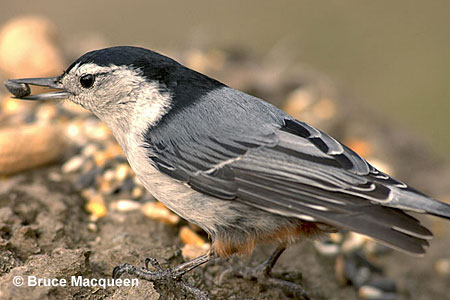The White-breasted Nuthatch is a small gray and white bird with a smart black cap, and a sharp, straight beak that looks slightly upturned.
This bird is a common resident of parks and woodlands in parts of southern Canada, in most of the USA, and in Mexican mountains.
Listen for its nasal calls and watch for it at feeders. If you see a gray bird with a black cap creeping on branches and down tree trunks, you have probably found a White-breasted Nuthatch.
On this page
Identification
The White-breasted Nuthatch is a small, sparrow-sized, gray and white bird with a short tail, and a dark cap.
On average, they are 5.75 inches long, have an 11-inch wingspan, and weigh 0.74 ounces. Males have a black cap that goes onto their nape but doesn’t reach their eyes.
The rest of their upperparts are gray, and they have some black and pale edging on the feathers of their long wings. Female White-breasted Nuthatches look very similar but usually have a gray cap with a narrow black border.
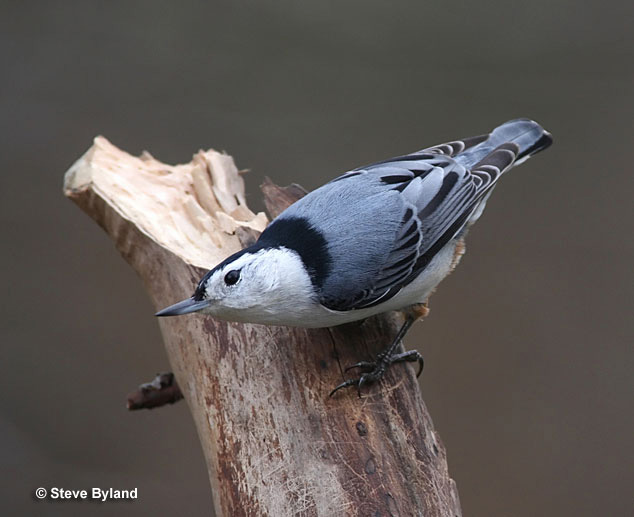
Both sexes of this friendly songbird have a beady black eye on a white face, and white underparts with a gray wash on their flanks. With a close look, we can also see chestnut markings on their lower belly and undertail.
They also have a fairly long, slender, sharp gray and black beak, and large, gray feet with small sharp claws.
White-breasted Nuthatches have a bounding flight pattern where they fly with a few quick flaps and then hold their wings closed. During flight, small pale patches below each wing is sometimes visible, and they show black and white on their short tail.
This species makes nasal “yenk” and repeated short calls that sound like nasal laughter.
Food
The White-breasted Nuthatch feeds on a wide variety of insects, insect eggs, and larvae. It catches beetle larvae, ants, weevils, and tent caterpillars, as well as many other insects it happens to find.
This species also feeds on seeds, especially in fall and winter. With that in mind, it’s no surprise that it is a regular visitor to bird feeders. They can feed on sunflower seed, corn, other seeds, and suet.
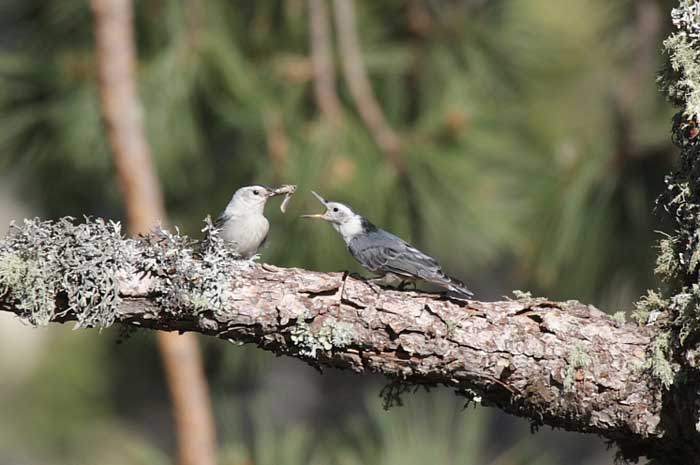
White-breasted Nuthatches forage by creeping along branches and up and down tree trunks. As they move along, they pick insects from the bark, and explore every part of the branch.
These birds also use their sharp, chisel-like beak to hammer at and pry up bark that hides insects.
Once in a while, this species also picks up seeds from the ground but only briefly. It can forage at all heights, and in places where people feed them, they can fly in to perch on your hand, or even land on your leg!
White-breasted Nuthatches find seeds in the same way they search for insects. They pick them from twigs but also take seeds from feeders.
In the fall, these birds also store seeds and nuts under bark to have food during the winter months.
Nesting and Eggs
The White-breasted Nuthatch nests in tree cavities. It can use natural cavities and old woodpecker holes but only occasionally uses a nest box.
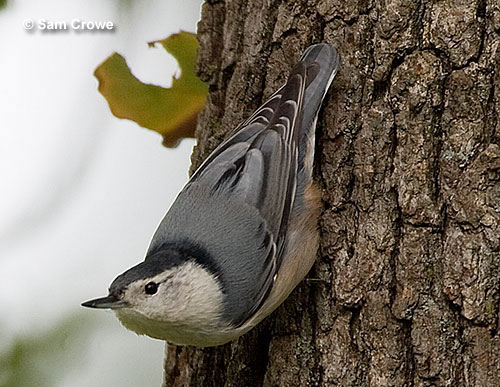
Nesting cavities are anywhere from 15 to 60 feet above the ground and can be situated in oaks, maples, pines, or other tail trees.
After a nest site is chosen, the female nuthatch doesn’t construct an elaborate nest but does put some grass and other soft materials at the bottom of the cavity.
She lays six eggs on that nesting material and incubates them for 12 days. The eggs are pinkish, cream-colored, or white with reddish-brown, purple, and gray spots and markings.
They are 0.35 inches long, but nothing is known about their weight. During the incubation period, the female rarely leaves the nest and is fed by her mate.
After the eggs hatch, for the first couple weeks, the female still spends most of her time brooding the nestlings.
Her mate continues to bring her food as well as food for the babies. However, around two weeks after hatching, the mother bird also starts to bring them food.
The young nuthatches leave the nest nearly four weeks after hatching but continue to stay with their parents for several more weeks.
Current Situation
White-breasted Nuthatches occur in various parts of southern and western Canada, much of the USA, and in montane areas of Mexico.
They live in a lot of places but are absent from much of the Great Plains, a large part of Texas, deserts, and from most of Florida and the “Deep South”.
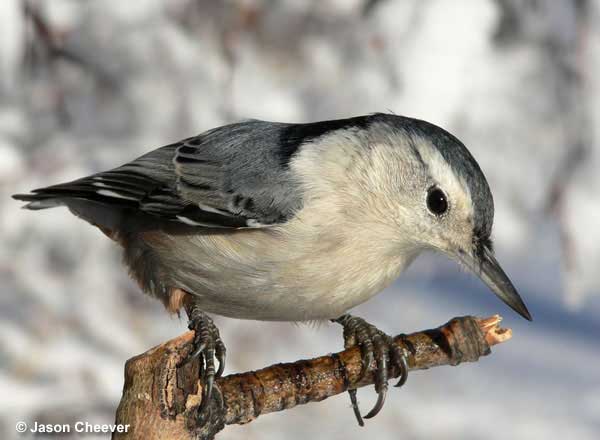
This bird frequents a variety of forest and woodlands habitats including large parks. In most places, it is a permanent resident but some birds from the northern part of their range can migrate for short distances.
The White-breasted Nuthatch is listed as Least Concern in the IUCN Red List. It has stable populations and is common throughout its range.
However, this species is dependent on mature trees and woodlands for survival. With that in mind, it can be affected by the removal of dead trees that provide nest sites.
Forest destruction and cutting down big trees also eliminate important habitat for the White-breasted Nuthatch.
Facts
- To protect their nest, White-breasted Nuthatches often use a crushed beetle to smear the entrance and inside of the cavity. This may give the nest a noxious odor that repels squirrels and other nest predators.
- White-breasted Nuthatches often forage with chickadees and other small birds. With more eyes watching for predators, the more likely one will be spotted before it can attack. This is especially useful for nuthatches because it’s difficult for them to notice predators while they inspect branches and tree trunks.
- This species gets its name from its habit of holding down a nut or seed and then opening it by hacking (hatching) at it with its beak.
- The White-breasted Nuthatch prefers to take unshelled sunflower seeds from feeders and store them for later use. That way, when it needs to eat, the bird won’t have to waste any time or energy in opening the seed to eat it.
- There are three main groups of White-breasted Nuthatches; one in Canada and the eastern USA, another in the Rocky Mountains and Mexico, and one on the Pacific Coast. Each have small differences in plumage and bill size, but recognizably different voices. Based on these differences, some people believe they should be separate species.
Similar Species
The White-breasted Nuthatch is a distinctive bird. However, there are three other nuthatch species that use similar habitats, and could be confused with it.
Red-breasted Nuthatch
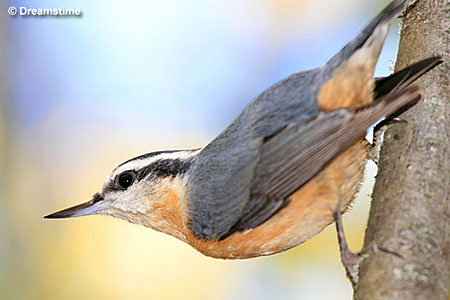
Red-breasted Nuthatches are shaped like White-breasted Nuthatches, but they are smaller and have a narrow white eyebrow. It also has some orange color on its underparts and a smaller bill.
Brown-headed Nuthatch
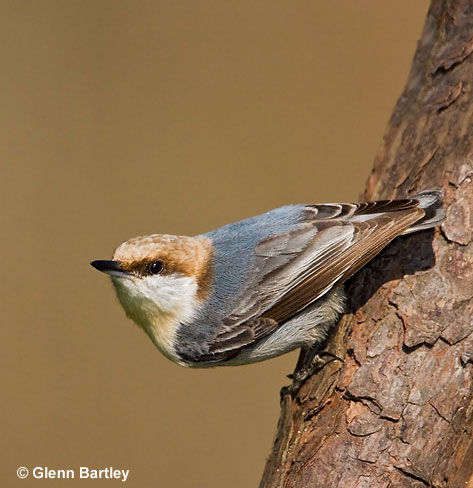
The Brown-headed Nuthatch is a tiny bird that sounds like a squeaky toy. It has a brownish head, dark line through its eyes, and doesn’t have any black on its crown.
Pygmy Nuthatch
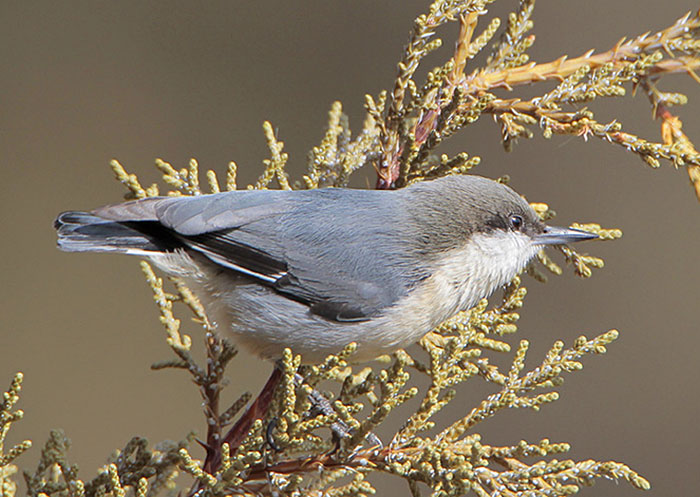
Photograph © Greg Lavaty
The Pygmy Nuthatch is another tiny bird much smaller than a White-breasted Nuthatch. It makes high-pitched, chippering sounds and has a grayish cap with a dark line through its eyes.
Frequently Asked Questions
Are White-breasted Nuthatches woodpeckers?
No, White-breasted Nuthatches are not woodpeckers. These small birds are in the nuthatch family, the “Sittidae”.
Where do White-breasted Nuthatches live?
White-breasted Nuthatches live in forest and woodlands in parts of western and southern Canada, and in many areas of the USA. They also occur in the mountains of Mexico but are absent from deserts, open habitats, and from much of Texas, Florida, and parts of the “Deep South”.
Are White-breasted Nuthatches friendly?
Yes, White-breasted Nuthatches are friendly birds. They often visit feeders and can become tame around people.
What is unique about the Nuthatch?
The Nuthatch is one of the few birds that creep down tree trunks, headfirst. It is also one of the few birds with a slightly upturned beak.
What trees do Nuthatches nest in?
Nuthatches nest in pines, oaks, maples, and other trees. However, since they only nest in cavities, they need dead limbs and dead trees.

